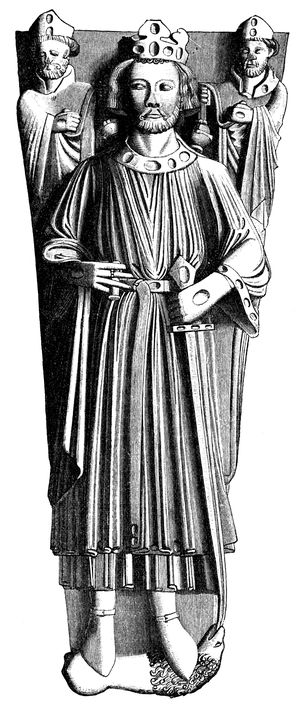20 June 1210: King John of England landed at Crook, near Waterford on this day.
Johannes, grandson of the Empress [Matilda], king of the Saxons, came to Erinn, with a great fleet, in this year
After arriving he commanded a great hosting of the men of Erinn to Ulidia, to apprehend Hugo de Laci,
or to expel him from Erinn, and to capture Carraic-Fergusa.
Hugo left Erinn, and the persons who were defending the
Carraic abandoned it, and came to the king; and the
king put men of his own company into it.
Annals of Loch Cé 1210 AD
Sailing from south Wales he was to remain in Ireland throughout the rest of the summer.
His mission in Ireland was not so much to subdue the Irish Kings who still held power over large swathes of the Country, but instead to bring to heel the more powerful of the Anglo-Norman Lords who defied him. King John was a most unpopular Monarch in England and faced constant trouble with his Lords and Barons who resented his attempts to rule them. A ruthless and devious man he - probably with good reason- trusted very few of his councillors who advised him.
The main objects of his attention were the De Lacy family, specifically Walter Earl of Meath and Hugh the Earl of Ulster. He believed they could act as a power base for malcontents back in England. Indeed they had backed the struggle of the once powerful Marcher Lord William de Braose against the King. It was to crush this family and punish the De Lacy's for their lack of loyalty that drove him to take a well armed military force to Ireland.
De Braose fled to England when he heard of the King's movements. There he endeavoured to make peace with his master, but failing to do so, he carefully avoided putting himself in his power, and took refuge in France.
John had been to Ireland before in 1185 when his father King Henry II had given him the title 'Lord of Ireland', but John had turned his journey into a Fiasco but upsetting the Irish kings with his youthful folly and the Gaels resented his attitude to them.
After arriving in Waterford he came to Dublin where he was well received and after leaving the capital he advanced into Meath from which Walter de Lacy then fled. King John then met up with King Cathal Crobhderg O'Conner of Connacht near Ardbraccan, Co Meath. King Cathal recognised him as his Lord in return for being re-assured as the recognised & rightful King of Connacht. The two kings then proceeded northwards where they besieged the powerful fortress of Carrigfergus in Ulster which was taken, though Hugh made good his escape.
While in the North he also parlayed with King Aedh O'Neil of Tir Eoghan (Tyrone), whom he wished to secure homage and take hostages from. Keeping his distance, O'Neill made a pretence of wanting to help with the siege and being prepared to offer some kind of agreement to subordinate himself to the English King, but he pleaded for time to consult his advisors. He donated a supply of cattle to feed John's troops. He was though really loath to submit and have to give over important hostages, incl. his own son, to such a volatile character as King John. The negotiations fizzled out and O'Neill backed off and went home.
Cathal Crovderg was in a weaker position as his kingdom was riven by rivalries which he had to return home to sort out. He had made a promise to hand over his eldest son, Aed O'Conner, to King John. He would then have him conveyed to England as a security against King Cathal remaining in submission. However Cathal's wife would have none of it and the Irish king had to return to King John empty handed. When they next met at Rathwire in County Westmeath, as arranged, but without his son, the King of England was anything but pleased and seems to have forcibly apprehended four of Cathal's sub-kings and royal officers, whom he brought back to England.
Soon after King John left Ireland, arriving back at Fishguard in Wales on 26 August. His Expedition here was overall a success for him. He had smashed the power of the De Lacy's, secured the city of Limerick, reformed the government of Dublin and the eastern counties and brought even as powerful figure as William Marshal of Leinster, the greatest Knight of the age, to heel.
But his attempts to bring the Kings of Connacht and Tir Eoghan under his thumb both failed, and while not the primary objective of his expedition John's ham fisted attempts only alienated these Irish Kings who rightly did not trust this ruthless man.
A final and horrible chapter to this attempt to punish his opponents was the fate of Maud De Braose and her infant son William de Braose. Captured in Scotland they were conveyed in chains to King John who had them imprisoned in Windsor Castle. They were locked up together but only given food and no water on the first day of their incarceration. Thereafter nothing. When the jailors yanked open the door to their cell 11 days later all that was left was their emaciated corpses.
John died in 1216, probably from dysentery, as he desperately tried to hold his Kingdom together from Revolt. His expedition here was the last by a serving King of England for 184 years until Richard II, another unloved Monarch, arrived here in the year 1394.
Effigy of King John [above] from his tomb in Worcester Cathedral

No comments:
Post a Comment